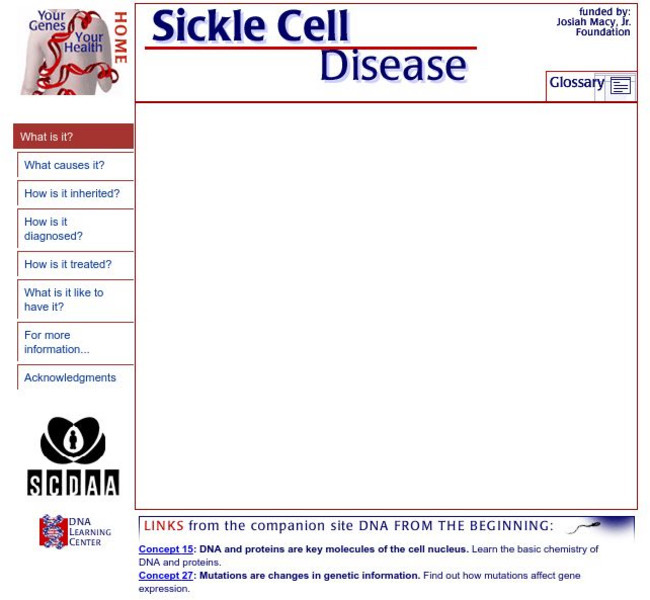Hi, what do you want to do?
Howard Hughes Medical Institute
Icefish Blood Adaptations: Viscosity
Most fish freeze to death when the water is too cold, yet some fish live in the Southern Ocean where the water is often below freezing. Scholars use two models representing the blood from most fish versus the blood from Antarctic fish....
Howard Hughes Medical Institute
Population Genetics, Selection, and Evolution
The Hardy-Weinberg principle states that alleles and genotypes remain constant in the absence of evolutionary influences. Scholars complete a simple hands-on activity applying the Hardy-Weinberg principle to sample data. They observe how...
Give and Let Live
Blood and Transplant: Blood
Why is blood donation so important, anyway? Science and health classes across multiple grades benefit from an in-depth look into the need for and process of blood donation. With an emphasis on presenting the topic in a non-threatening...
Curated OER
Antibody Center Template
In this antibodies worksheet, students use model diagrams of antigens, antibodies and blood cells to develop a visual understanding of the immune system. They draw diagrams of antibodies and antigens attached to each other and answer...
Curated OER
Human Blood: Microviewer
In this human blood: microviewer activity, students answer questions about blood, red blood cells, white blood cells, phagocytosis, blood type B, fibrin, sickle cells, and infected blood. Students also draw quick sketches of a human...
Curated OER
Infection Wars
Students explore how our bodies fight infection. Using a microscope, they observe red blood cells, white blood cells and different bacteria under a microscope.
Curated OER
Introduction to the Circulatory System
Fifth graders study the circulatory system. In this circulatory system, 5th graders participate in five stations with different activities at each station. Students discuss their findings from each station.
Curated OER
Explore Rx Quiz
In this exploring prescriptions instructional activity, students answer 6 multiple choice questions related to diseases, medicine, the human body and poisonous plants. Students use an on line web site that gives them an immediate score.
Curated OER
Internal Systems and Regulation
In this internal systems and regulation worksheet, students correctly decide if given statements are true or false. Students apply information learned about the circulatory system to the given statements to determine statements of truth...
Curated OER
Viruses
For this virus worksheet, 9th graders study the graph shown that illustrates the sizes of viruses, bacteria, and other structures. Then they state how large a red blood cell is and how large the smallest viruses are that affect plants....
Curated OER
Blood
In this blood learning exercise, students describe the four functions of blood. Then they write what each part of the human body illustrated does below the picture. Students also complete the table on possible blood types of a receiver...
Curated OER
The Journey of a Red Blood Cell
Fifth graders examine how a red blood cell travels throughout the body. Using a model, they recreate the flow of blood through the heart. They also label the lungs and the differece between the blood that enters the heart and the blood...
Curated OER
Blood Components Web Hunt
Fifth graders watch a short video on blood and complete worksheets on the components of blood. They navigate the Internet to investigate the components of human blood. They complete worksheets with a partner and exchange sheets among...
Curated OER
Our Systematic Body
Students explore several parts of the body system in the eight lessons of this unit. Through several hands-on activities, the skeletal, muscular, digestive, circulatory and nervous systems are observed.
Aetna Intelihealth
Aetna: Inteli Health: Iron Deficiency
Thorough overview of iron deficiency. Includes information on symptoms, treatment, prevention, and much more.
Aetna Intelihealth
Aetna: Inteli Health: Vitamin B12 Deficiency
Thorough overview of vitamin B12 deficiency. Includes information on symptoms, treatment, prevention, and much more.
PBS
Pbs Learning Media: Sickle Versus Normal Cell
Background image of normal disc-shaped red blood cells from the University of Utah. Inset shows sickled red blood cells, curved and rigid, from the Virginia Medical College.
Michigan Reach Out
Newton's Apple: Blood Typing
Describes blood typing and explains some information in reference to blood composition.Provides links to resources and a blood typing lab.
Cold Spring Harbor Laboratory
Your Genes, Your Health: Sickle Cell
A very easy to understand site on sickle cell. Learn about the causes, symptoms and treatment of sickle cell disease.
Palomar Community College District
Palomar College: Blood Components (Tutorial)
This review of what makes up human blood is easy to read and understand. There are guides to pronunciation and glossary links as well as a self quiz to check your understanding.
OpenStax
Open Stax: Anatomy & Physiology: An Overview of Blood
Find out about the characteristics and components of blood with informational text, diagrams, examples, and review questuons.
OpenStax
Open Stax: Anatomy & Physiology: Erythrocytes
Learn about the anatomy and the various steps in the life cycle of an erythrocyte, and find out about the composition and function of hemoglobin.
TeachEngineering
Teach Engineering: Simple Coulter Counter
Students build and use a very basic Coulter electric sensing zone particle counter to count an unknown number of particles in a sample of "paint" to determine if enough particles per ml of paint exist to meet a quality standard. In a lab...
WebMD
Web Md: Complete Blood Count (Cbc)
This site from WebMD provides an extremely detailed description of a complete blood count, how it is taken, what it measures, and what the results tell you. Links to important terms within the text and a chart that shows average amounts...


























